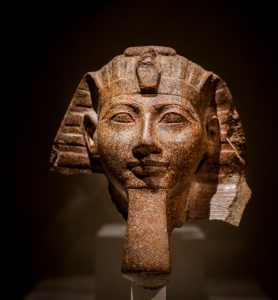Running outside, chasing your friends, playing with Legos–these are things you might remember doing as a young child. However, from the late 1700s to the mid-1800s in Britain, being paid meager wages and working for as much as sixteen-hour days with dangerous mining equipment was the norm for many young, British children. During the Industrial Revolution this was an ugly reality. Many working-class families found it necessary to have their children work alongside them in the mines. Because of their size and cooperation, and because it was easier to pay them less, these children were paid about five times less than men for the same number of hours worked, which for these young miners could be up to fourteen-hour days.1

Before the Mines and Collieries Act of 1842, children as young as four were allowed to work in the mines.2 Just imagine such young children running around a dark coal mine–it simply does not sound safe at all. These children were hired to be able to get into those hard to reach places that fully grown adults were unable to get into. During the Industrial Revolution, coal was a major source of energy, and was extremely important because it burned hotter than wood charcoal. The primary use of coal was used as a source of energy, and used to power the steam engines of factories, where many other children also worked. Because of its high demand and necessity, it helped increase jobs for the working people. Because of these factories, major industrial cities such as Birmingham, Manchester, and Liverpool, grew at a fast pace from small villages into large cities.3

In British coal mines, children typically had one of three jobs. Trappers, typically the youngest, would open and close the wooden doors–also called trap doors–to allow fresh air to flow through the mine. These trappers would sit in darkness for almost twelve hours at a time. It may seem a simple task, but if one of these little ones fell asleep, the job could become very dangerous. Other jobs were the tasks of hurrier and thruster. These jobs were usually given to older children and women. These workers had to pull and push tubs that were full of coal along the roadways, all the way to the pit bottom. The hurriers would be harnessed to the tub, and the thrusters would then help hurriers by pushing these tubs of coal. The thruster would have to push tubs of coal weighing over 600 kilograms from behind with their hands and the tops of their heads. The thrusters, mainly older girls, had to carry these baskets of dug coal, which were much too heavy for them. Because of their heavy weight, it would then cause their young, growing bodies to develop with deformities. The last typical job was the getter. This one was typically assigned to the oldest and strongest, usually grown men or strong, older teens. This job required them to work at the coal face, cutting the coal from the seam with a pickaxe. This was typically the only job where they would use a candle or safety lamp for light, as cutting the coal required it.4 Although the work at the coal mine may not seem very difficult, it was very dangerous. In one unnamed coal mine, 58 of the total 349 deaths in one year involved children thirteen years or younger.5

Those who worked in coal mines–whether below or above ground–were exposed to life-threatening working conditions that could ultimately be detrimental to their health. Children, mainly boys as young as eight, worked as breakers. Here, the coal was crushed, washed, and sorted according to size. The coal would come down a chute and along a moving belt. These breaker boys would work in what was called the picking room. Here, they would work hunched over for ten hours a day, six days a week, sorting the rock and slate from the coal with their bare hands. If their attention even drifted for a second, they could lose a finger in the machinery.6 The work also resulted in their exposure to a large amount of dust. In some cases, the dust was so dense that their vision would be obstructed. This dust would also get into their lungs, which needless to say, was terrible for their health.7 These children sometimes even had a person prodding or kicking them into obedience to make sure their attention did not stray.
These working conditions for children continued until the United Kingdom’s Parliament passed the Mines and Collieries Act of 1842. The act included a report that informed the public about how children as young as five years old were working as trappers for “twelve hours a day and two pennies a day.”8 It was not until the Children’s Employment (Mines) Report came out alongside it in 1842 that Parliament passed the act that all boys and girls under the age of ten were not allowed to work in the coal mines.9 Even after this law prevented children under fourteen from working in the mines, people still found ways around it. For example, since some regions did not have a compulsory registration of birth, someone could easily lie and claim that these boys were simply “small for their age.” Finally, with this legislation came the snowball effect of humanitarians and a larger awareness of health and safety regulations for workers, which led to the start of the end of child labor in England.10
- Children’s Employment Commission First Report of the Commissioners (Mines), (Halifax: Irish University Press, 1842), 77-81. ↵
- Encyclopedia Britannica.com, December 2012, s.v. “Anthony Ashley Cooper, 7th earl of Shaftesbury,” by Editors of Encyclopedia Britannica. ↵
- New World Encyclopedia, February 2017, s.v., “Child Labor,” by New World Encyclopedia Contributors. ↵
- Great Britain Commissioners, The Condition and Treatment of the Children employed in the Mines and Colliers of the United Kingdom Carefully compiled from the appendix to the first report of the Commissioners With copious extracts from the evidence, and illustrative engravings, (London: 1842), 19-59. ↵
- J. M. Mason, “Protection of Children,” The Westminster Review Vol. 36 (1841): 66. ↵
- Jane Humphries, “Short stature among coal-mining children: A comment,” Economic History Review 1, no. 3 (1997): 533. ↵
- Jane Humphries, “Short stature among coal-mining children: A comment,” Economic History Review 1, no. 3 (1997): 535. ↵
- Encyclopedia Britannica.com, December 2012, s.v. “Anthony Ashley Cooper, 7th earl of Shaftesbury,” by Editors of Encyclopedia Britannica. ↵
- “Early Factory Legislation.” Parliament. UK. (April 9th, 2017). ↵
- J. M. Mason, “Protection of Children,” The Westminster Review Vol. 36 (1841); 45-47. ↵



98 comments
Joshua Breard
I found this article to be troubling but also very eye opening. From children working ridiculous hours, young four year olds laboring, poor conditions in the mine, and this is only the tip of the iceberg as to what is wrong. I wish that issues like this go away but they stick around so it is in articles like this. Articles like this are like bring awareness of our past so we can avoid it the future. Great article!
Eduardo Foster
It is sad to know how children were treated back during the Industrial Revolution! People back in days did not think what the damage they were doing to the kids. It actually amazes me how long the Parliament took to overcome the rule so the kids could not suffer this treatment. Great article and keep it up with the good work!
Megan Barnett
It is depressing to read that anyone would allow such treatment to any human being let only a child. It made me wonder what hard times families were going through that they needed their four year old to work in a place that would harm their health, or in worse cases their life. I am glad that I live in a place where today there is regulations and laws preventing this conduct from occurring again.
Tara Sellers
It is sad to know that children used to have to work in unsafe environments. I could not imagine having to work in such a dark environment. The article does not say exactly what medical effects working in coal mines had on young children. I would also have liked if they told us if their life span decreased because of the work they did.
Soteria Banks
Reading this article kind of made me realize why you have to be a certain age to work, because older people tend to manipulate the younger kids because they have authority. and also the children did not have a choice to work. My grand father work in a type of environment just like that and he got black dust and his lungs were affected . which cause he to die a early then he should have. but back then was just so crazy, those times were hard for America, and there is nothing we can do about it.
Amanda Figueroa
This article explains well the abuse these children were put through at such a young age. I did not know that children as young as four were able to start working. How would these children put up with the conditions and long hours? They must have had a lot of courage to withstand this. It took Parliament long enough to pass an act stating how obviously wrong this was.
Mario Sosa
When I hear about child labor in 19th century Britain, factory workers and chimney-sweepers come to mind, but I never knew about child workers in the coal mines. I find it to be most inhumane to have a 4 year old child sitting in the dark for 12 hours a day opening doors. It’s just as bad as the young women who had to push a 1,300 pound cart around. As grim as this topic was, this was also a really thought-provoking article, superb job!
Liam Gillooly
As a descendant of immigrants, I myself know the pain of child labor. The fact that young, innocent kids were robbed of their childhoods is heart wrenching. I wish I could do something to rectify the pain and suffering experienced by these children. I am so glad that our government has taken steps to protect the rights of the innocent. Thank you for the article.
Richard Navarro
Its crazy to think how laws are today. Many children don’t understand the suffering of child labor. This article is very good due to its informative nature of the topic. So many kids complain about the littlest things today, yet they do not know what real suffering is. I feel as if this article should be displayed on many websites so it can put things into perspective for others. Child labor is NOT acceptable.
Carlos Aparicio
Children today really don’t appreciate the love and care that surrounds them. The late 1700’s and mid-1800’s was such a shame to people of all ages with the working conditions they experienced. This article gave me two important view points regarding the children’s view and the business end. It’s a disgrace how a law had to be passed in order to stop those ugly working conditions. Very detailed article in my opinion!